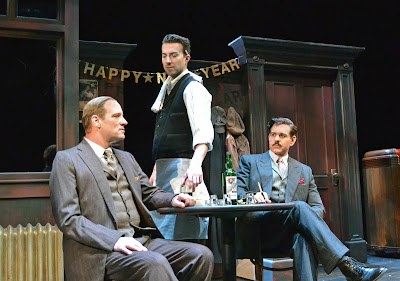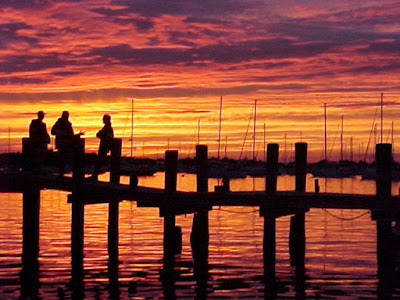 Blow out the candle of the present and imagine going back
in time into Tennessee Williams’ memory revealing his relationship with William
Inge. That opportunity has been remarkably
created by Terry Teachout in his latest play, Billy and Me, world premiering at Palm Beach Dramaworks. Williams and Inge were among the playwright
elites, friends, and possibly even lovers. Teachout, a well known critic, playwright, and
writer, is guided more by his knowledge of the two men and their plays than by
historical record. He has created a
provocative new drama of uncompromising art and imaginative truth, vividly executed
under the direction of William Hayes, PBD Producing Artistic Director, who inspired
the idea for the play. In fact, the play is a major collaborative effort
between these two professionals.
Blow out the candle of the present and imagine going back
in time into Tennessee Williams’ memory revealing his relationship with William
Inge. That opportunity has been remarkably
created by Terry Teachout in his latest play, Billy and Me, world premiering at Palm Beach Dramaworks. Williams and Inge were among the playwright
elites, friends, and possibly even lovers. Teachout, a well known critic, playwright, and
writer, is guided more by his knowledge of the two men and their plays than by
historical record. He has created a
provocative new drama of uncompromising art and imaginative truth, vividly executed
under the direction of William Hayes, PBD Producing Artistic Director, who inspired
the idea for the play. In fact, the play is a major collaborative effort
between these two professionals.
It is a memory play like The Glass Menagerie which is a centripetal force throughout. Williams is the narrator and a character in Billy and Me as is Tom in The Glass Menagerie. Both plays
even end with the same three words.
In the opening act, Williams is anxiously awaiting
reviews of The Glass Menagerie after
Chicago tryouts on New Year’s Eve, 1944. The setting is a gay bar where he is also waiting
for a relatively unknown critic he once met who has come to review the play,
William Inge. Inge who is furtively gay,
shows up in a faltering state, terrified of the bar scene and seeing Tennessee
Williams again. He is stunned by his unpretentious
way of living his life openly and particularly of his gift for poetic
language. He is so staggered by the
play’s force and honesty that he timidly confesses he’s thought of becoming a
playwright himself. He is goaded on by
Williams: “You’ve got to write about sissy little Billy Inge. You got to be
him. Face it and tell it, starting right here in this dump. No more secrets! No
more shame! Live your life! You hear me? It’s all you’ve got! There isn’t
anything else!”
 |
| Tom Wahl, Nicholas Richberg; Photo by Alicia Donelan |
And it is language
Teachout so perfectly captures, bringing his interpretation of both men to the
stage, the repressed Inge, and the charismatic, poetic Williams. He incorporates special conceits, the audience
being allowed behind the hallowed veil of backstage, the setting of the play’s
scenes and breaking the fourth wall to speak to the audience or visiting his
inner self to address his mother and sister Rose.
It’s a dizzying journey and the second act bursts upon
the stage some 15 years later, with the unthinkable, Inge’s first commercial
failure, A Loss of Roses being panned by the critics after years of Broadway
and film hits. In contrast to the sleazy
bar scene of the first act we witness Inge’s badge of
prosperity, his Sutton Place apartment, replete with a Willem de Kooning painting
and all the trappings of monetary success as the framed posters from the
Broadway productions of Come Back, Little
Sheba, Picnic, Bus Stop, and The Dark at the Top of the Stairs attest.
In contrast to Tennessee Williams’ rise in the first act,
is his apparent career stagnation in the second, which brings out his monstrous
jealousy of Inge, in spite of his apparent attempts to console his friend. He reminds Inge that it was his encouragement
and contacts – particularly Audrey Wood his agent -- which paved the way for his
friend’s success. The table is set for
the play’s gripping climax which begins with a contretemps between the two
about their plays, the kind of argument no friend can win, gathering intensity to
a near calamitous result.
 |
| Nicholas Richberg as Tennessee Williams; Photo by Cliff Burgess |
As much as Tennessee Williams is the luminary of Billy and Me, the play’s dramatic arc is
about William Inge. But the story about
how Inge became a playwright and the impact Williams had on his career, could
not have been compellingly told without the bravura performance by Nicholas
Richberg who strikingly captures Williams’ flamboyant persona. His transformation in real time, on stage
from the aged Tennessee Williams to his younger self, and then back again is heartbreakingly
effective. His comic timing is carefully executed, inhabiting Williams’
personal pathos and vitriolic embrace of the truth, frequently in an alcoholic
daze. He carries the play’s poetry,
some quoted from The Glass Menagerie
but most penned by Teachout. “Beauty is
truth, truth beauty – start with the truth and then make it beautiful.”
In many ways Tom Wahl’s challenge in portraying William
Inge is the playwright himself. Teachout
could take just so many liberties with a character who mostly eschewed the
public spotlight, especially when held up to the brassy extroverted nature of
his counterpart. Wahl stoically holds
his own, courageously portraying a conflicted character, shy, insecure,
secretly gay, and an alcoholic like Williams. His role as straight man is compellingly acted
with self loathing and awkward pauses that successfully capture a deeply
disturbed man.
 |
| Tom Wahl as William Inge; Photo by Cliff Burgess |
There is a reference made in both acts that the two
writers are “speckled eggs.” As Inge
relates it, his mother “called me…her ‘speckled egg’…. I wonder how you ever
got into my nest.” Wahl’s character
never is able to break through the shell.
It is heartbreaking to watch, a metaphor for anyone who has ever felt like
an outsider. It’s a difficult part and
Wahl emerges as that self-effacing, insecure writer, a character with whom the
audience can easily empathize.
Cliff Burgess, a PBD veteran, effectively plays three
different characters, the impassive stage manager, the flirtatious waiter, and
a somewhat comical doctor. All three
roles are integral to the drama, validating both playwrights. He creates needed pauses from the taut action
on stage.
 |
| Tom Wahl, Cliff Burgess, Nicholas Richberg; Photo by Samantha Mighdoll |
The skillful scenic design by Victor Becker is
representational, effectively highlighting the stark contrast between the dank
and seedy bar room scene of the first act to Inge’s affluent Sutton Place
apartment in the second. Each part of
the scenery is moved as Williams recalls it from memory. In fact, when the audience arrives, the stage
is simply a backstage set creating an anticipation of the action to follow.
Paul Black, the lighting designer picks up on that with
constructive lighting, carving out space where there may be a black wall in the
background, casting light to make the abstract seem real. His lighting on the aged Tennessee Williams
is particularly effective in achieving the suspension of disbelief.
David Thomas is the sound designer and there is an interesting
back-story to his PBD debut. Three years
ago Thomas was the sound designer for the off-Broadway revival of Inge’s A Loss of Roses which is the subject of
Act II of this play. Terry Teachout
reviewed that revival, praised the play, and David Thomas’ musical selections,
and unknown to him, Bill Hayes hired him for Billy and Me. Clairvoyantly,
Williams says to Inge: “Hell, maybe all those bastards are wrong about Roses. Who knows? Maybe in fifty years
some hotshot producer will dig up the script and a new bunch of bastards will
go see it and say, ‘You know what? Those other bastards—they were wrong!’” Teachout is ironically one of the “new bunch.”
Thomas has a lot to work with for sound, the singing of
the drunken men in the unseen back room of the bar, the music on the jukebox,
and magical elements that work with the memory aspects of the play. As quoted by both Williams and Inge (from The Glass Menagerie): “In memory everything
happens to music” and the sounds are evocative.
Costume designer extraordinaire, Brian O’Keefe, who is
PBD’s Resident Designer, while needing a limited number of costumes for the
five different characters plus stagehands in the play, imaginatively reinforces
all the personalities and the different periods of the two acts with his usual
creative touch.
William Hayes, the Director, has taken many dramatic inventions
and put them seamlessly together into one flowing production, and we’re caught
up in the illusion. His inspired staging
clearly conveys Teachout’s structure and words and the underlying message: be
true to ones’ self and if you are a writer, write --- claim your artistic
destiny!
As Williams said in the prologue to The Glass Menagerie, “Memory takes a lot of poetic license. It
omits some details; others are exaggerated, according to the emotional value of
the articles it touches, for memory is seated predominantly in the heart.”
The same can be said for this superb production, worthy of
this world premiere, destined to go beyond its Palm Beach Dramaworks origins.


















